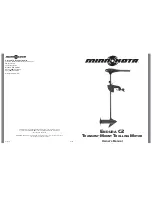
Designer Reference Manual
USB08 Evaluation Board
232
Universal USB Device Driver (USBIO)
MOTOROLA
Universal USB Device Driver (USBIO)
and in a location of your choice. The Installation Wizard copies
also the USBIO driver binary file usbio.sys to the same location as
the INF file. You can use these files at a later time to install the
USBIO driver manually.
You can use the button labeled “Run USBIO Application” to start
the demo application that is included in the USBIO package. The
application allows you to test several USB operations manually.
Please refer to
for further
information.
To quit the USBIO Installation Wizard, click Finish.
E.8.2 Manual Installation: The USBIO Setup Information File
A Setup Information File (INF) is required for proper installation of the
USBIO device driver. This file describes the driver to be installed and
defines the operations to be performed during the installation process.
An INF file is in ASCII text format. It can be viewed and modified with any
text editor, Notepad for example. The contents and the syntax of an INF
file are documented in the Microsoft Windows 2000 DDK.
The INF file is loaded and interpreted by a software component that is
built into the operating system, called Device Installer. The Device
Installer is closely related to the Plug&Play Manager that handles hot
plugging and removal of USB devices. After the Plug&Play Manager has
detected a new USB device the system searches its internal INF file data
base, located in
%WINDIR%\INF\
, for a matching driver. If no driver can
be found the New Hardware Wizard pops up and the user will be asked
for a driver.
The association of device and driver is based on a string that is called
Hardware ID. The Plug&Play Manager builds the Hardware ID string
from the 16-bit vendor ID (VID), the 16-bit product ID (PID), and
optionally the revision code (REV). The string is prefixed by the bus
identifier USB. Examples for Hardware ID strings are:
USB/VID_046D&PID_0100
USB/VID_046D&PID_C001&REV_0401
USB/CLASS_09&SUBCLASS_01&PROT_00













































